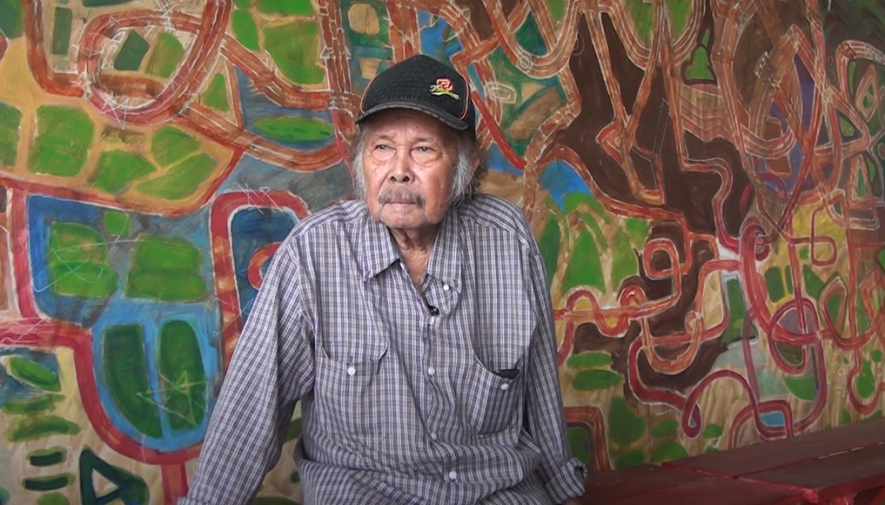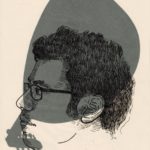Amrus Natalsya: The Last, Farewell And Thank You
No Comments yet
Amrus Natalsya – Image: YouTube
02-03-2024 ~ Legendary Indonesian artist Amrus Natalsya passed away at the age of 90 on January 31, 2024, at 7:30 p.m. The artist, who came of age just as his country emerged from colonialism, leaves behind nearly seven decades of creative work. His work bore witness to the tumultuous history of Indonesia’s independence and unfinished revolution, and the long-held aspirations of the Indonesian people.
Amrus was born on October 21, 1933, in the North Sumatran town of Natal (from which his name “Natalsya” was taken). In 1954, after graduating high school, he entered the Academy of Fine Arts of Indonesia in Yogyakarta and began his lifelong commitment to his craft of painting and wood sculpting.
His artistic career was never an individual pursuit but was molded by the situation of his country, which had just gained formal independence on August 17, 1945. As the young Amrus was learning to create new worlds out of paint and wood, so too was the young nation of Indonesia trying to build an independent path out of the ravages of centuries of colonialism.
At a student exhibition on Javanese culture, Amrus’s wooden sculpture entitled “A Forgotten Blind” was purchased by President Sukarno himself. Indonesia’s first post-independence president is perhaps best known for convening the 1955 Bandung Conference. At Bandung, while Amrus was still at the Academy of Fine Arts, leaders of 29 newly or soon-to-be independent countries representing half of the world’s population stood up together against imperialism.
Seeing the August Revolution of 1945 as an incomplete one, many young artists like Amrus set themselves to the task of building an anti-imperialist and independent national culture that would pave the way to a socialist revolution. This was a period when organizations of Left artists were thriving. Lekra ( Lembaga Kebudayaan Rakyat or “The Institute for People’s Culture”) was one of these organizations, founded on August 17, 1950, just five years into Indonesia’s independence.
Lekra was likely the largest cultural organization not affiliated with a country to have ever existed. As the cultural front of the Communist Party of Indonesia (PKI), it would grow over the next 15 years to over 200,000 members and, including its supporters, 1.5 million—until its life was cut short by the 1965 coup. The latter was the pretext for the persecution and killings of millions of communists and sympathizers in the months that followed.
Amrus was one of the many artists who were arrested in 1965, only to be released in 1973. Four years before his arrest, he had helped establish the Sanggar Bumi Tarung collective. Joining him were like-minded leftist artists, including Misbach Tamrin and Djoko Pekik. Forming part of Lekra, the collective and its members not only produced new artworks but also developed theory around their creations. One of the key principles that Lekra developed was Turun ke bawah or turba (“descend from above”), which was concretized in the first national congress of Lekra as a theory to guide the artist’s work. This meant going down to the grassroots to work, eat, and sleep alongside laborers, landless peasants, and fishermen. They believed that only with the sharpened feeling and understanding of the life of the people—or rakyat—can an artist adopt a kerakyatan approach, which means creating artwork that serves the people.
Amrus was a firm believer in and practitioner of turba, which he saw as both a source of knowledge and an inspiration for creation. He lived among Central Javanese peasants. In one instance, after learning of a local land dispute that resulted in the deaths of eleven peasants, he created one of his most famous wood sculptures. The work was more than a beautiful object, it became a record of an event, an analysis of class struggle, and an embodiment of the Lekra principle kreativitas individual dan kearifan massa (“individual creativity and the wisdom of the masses”).
Most importantly, Amrus, like other political artists of his generation, defied the belief that art could be separated from politics. For Lekra artists, “politics was in command,” meaning that the foremost creative task was to create artwork that opposed imperialism and advanced the Indonesian revolution. But, for them, politics must always find its careful balance with artistry and aesthetics, and, like Amrus, an artist must be tirelessly committed to building his or her craft.
Amrus held his last solo exhibition in Jakarta in 2019. The rooms were filled with his signature “wood paintings,” which are intricate, colorful, and captivating. He created worlds with wood, three-dimensional scenes of everyday working-class life—a street market, a festival in Chinatown, a fishing village—where ordinary children, families, and people were always represented in multitudes. Every human being became a protagonist in the collective scenes that Amrus sculpted. As it was his last exhibition, the show was befittingly entitled, “ Terakhir, selamat tinggal dan terima kasih”(“The last, farewell and thank you”).
Amrus’s passing marks the final chapter of over seven decades of making artwork that served his people and an Indonesia whose revolution never saw its completion. Likewise, it has been nearly six decades since the horrors of 1965, when both the PKI and Lekra were effectively erased from political life and living memory. A Lekra poet, Putu Oka Sukanta, said, “Formal organizations can disappear; party organizations can be abolished, but the spirit lives if it is right.” May the spirit of Amrus, of Lekra, of Bandung live on for the artists of today, still seeking the path of making artwork that serves the people.
By Tings Chak
This article was produced by Globetrotter.
Author Bio:
Tings Chak is a researcher and art director at Tricontinental: Institute for Social Research.
Source: Globetrotter
You May Also Like
Comments
Leave a Reply







